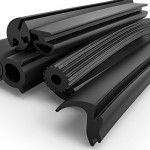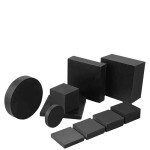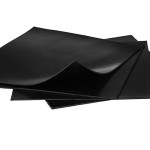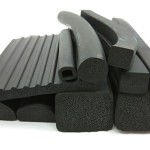
Rubber gaskets for glass clamping are gaskets used to seal between the glass and frame of surfaces such as windows, doors, skylights, automotive sunroofs, ships, aircraft, mechanical equipment, and other industrial products.
Glass clamping rubber gaskets are typically made from heat-resistant, aging-resistant, and waterproof synthetic rubber, with good elasticity and stretchability to ensure a tight seal between the glass and frame. These gaskets can be designed in various shapes and sizes to suit the requirements of each application.
Understanding rubber gaskets
Rubber gaskets are a type of component used to seal joints between surfaces in equipment, machinery, or piping systems. The gaskets are made from synthetic rubber or natural rubber and are capable of withstanding mechanical and chemical impacts in their working environment.
Rubber gaskets have numerous applications in various industries, including mechanical, automotive, marine, oil and gas, chemical, food, and medical industries. They can be used to seal joints in water pipelines, gas pipelines, power transmission components, and other equipment.
Depending on the intended use and working environment, rubber gaskets can be designed with different sizes and shapes, such as round gaskets, square gaskets, triangular gaskets, cone gaskets, and O-ring gaskets. These gaskets are manufactured using different materials to meet the diverse requirements of applications.
Using rubber edge trims
Rubber edge trims are a type of component used to cover and protect the edges of glass and frames in surfaces such as windows, doors, skylights, automotive sunroofs, ships, aircraft, and other industrial products.
Rubber edge trims are usually made from heat-resistant, aging-resistant, and waterproof synthetic rubber, with good elasticity and stretchability to fit different glass and frame edges. It is designed to protect the glass edges from external impacts, reduce noise, and create a gap between the glass and frame to prevent collision.
The applications of rubber edge trims include sound insulation, thermal insulation, waterproofing, shock absorption, and providing a better aesthetic appearance for the glass. They are commonly used in the automotive manufacturing, shipbuilding, aerospace, and other industrial product industries.
However, it is important to note that rubber edge trims are generally not designed to withstand heavy loads and strong tension. Therefore, it is necessary to ensure that they are used for protection and decoration purposes rather than load-bearing and connection purposes.
Using rubber trim for glass installation
Using rubber trim for glass installation is a common application in the glass and construction industry. Rubber trim ensures water tightness, waterproofing, and sound insulation for glass doors and windows. Here are some examples of using rubber trim in glass installation:
1. Glass edge trim: Rubber gaskets can be used to insert and hold the glass into the door or window frame. This creates a tight gap between the glass and frame, preventing water, wind, and dust from entering the interior. Glass edge trim typically has good elasticity and crack resistance, ensuring the longevity and performance of the glass over time.
2. Glass edge insert trim: Rubber gaskets can also be used to insert into the edge of the glass to create a tight gap between two glass surfaces. This can be applied in applications such as float glass, tempered glass, or glass protection.
3. Door seal gasket: Rubber gaskets can be used in door mechanisms to create a tight gap around the door panel. This provides soundproofing, thermal insulation, and waterproofing for the door when closed. Door seal gaskets have heat resistance, weather resistance, and corrosion resistance, ensuring the longevity and performance of the door over time.
4. Frame seal gasket: Rubber gaskets can also be used to seal gaps between the window frame and glass artwork or protective glass panels. This prevents water and dust from entering the frame and creates a sound barrier between the glass and frame.
Using rubber gaskets in glass installation not only improves the water tightness, sound insulation, and waterproofing but also creates stability and durability for the glass structure. When using rubber gaskets, the connections between the glass surfaces and frames are reinforced, minimizing movement and vibration, increasing the structural durability. Additionally, rubber gaskets have the ability to stretch and contract, reducing stress on the contact points between the glass and frame, increasing durability, and minimizing the risk of glass breakage.
It is important to select the appropriate type of gasket for specific applications when using rubber gaskets. Rubber gaskets can be manufactured from various materials such as nitrile, neoprene, EPDM, and silicone, each material having different characteristics and advantages. Therefore, choosing the right type of gasket to meet the specific technical requirements is crucial to ensure the best performance for your application.
Overview, the use of rubber gaskets in glass assembly is an effective solution to improve water tightness, sound insulation, and waterproofing for glass structures. At the same time, selecting the appropriate type of gasket to meet specific technical requirements is crucial to ensure optimal performance for your application.
Comparison between rubber gaskets and other materials in glass clamping
In glass clamping, various materials can be used, such as aluminum, steel, PVC, wood, or fiberglass. However, compared to these materials, rubber gaskets have the following advantages:
1. High durability: Rubber gaskets are made from natural rubber or synthetic rubber materials, which are capable of withstanding pressure and resisting various elements such as water, harsh weather conditions, UV rays, chemicals, etc. Therefore, rubber gaskets have high durability and typically have a longer lifespan compared to other materials.
2. Good heat resistance and elasticity: Rubber gaskets have good heat resistance and elasticity, allowing them to stretch and adhere tightly to the glass surface and frame, minimizing movement and vibrations, thereby increasing the structural stability.
3. Good sound insulation and waterproofing: Rubber gaskets have good sound insulation and waterproofing capabilities, helping to prevent noise and water from infiltrating the structure, creating a more comfortable living and working environment.
4. Easy installation and maintenance: Rubber gaskets are highly flexible and can be easily cut, bent, or processed to fit various technical requirements. Additionally, rubber gaskets are easy to maintain and replace when necessary.
However, there are also some disadvantages of rubber gaskets, such as higher cost compared to some other materials and the need for proper storage and usage to ensure longevity.
In summary, rubber gaskets are a good choice for glass clamping due to their advantages in terms of durability, heat resistance and elasticity, sound insulation and waterproofing, as well as easy installation and maintenance





Leave a Comment